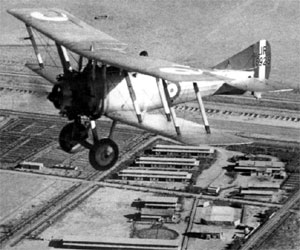Gloster Mars
| Nighthawk | |
|---|---|
 |
|
| Nieuport Nighthawk | |
| Role | Fighter |
| Manufacturer | Nieuport & General Aircraft |
| First flight | 1919 |
| Introduction | 1923 |
| Retired | 1938 Hellenic Air Force |
| Primary users |
Royal Air Force Greece |
| Variants |
Nieuport Nightjar Gloster Sparrowhawk |
The Nieuport Nighthawk was a British fighter aircraft developed by the Nieuport & General Aircraft company for the Royal Air Force towards the end of the First World War. Although ordered into production before the aircraft first flew, it did not enter large scale service with the RAF owing to unreliable engines. Re-engined aircraft did see service in Greece, serving from 1923 to 1938.
The Nieuport & General Aircraft Co. Ltd. was formed on 16 November 1916 to produce French Nieuport aircraft under licence. During 1917, hiring Henry Folland as chief designer, the company started to design its own aircraft, with the first type, the Nieuport B.N.1 fighter (the designation signifying British Nieuport) flying early in 1918.
To produce a fighter to replace the Sopwith Snipe in service with the RAF, the Air Ministry produced RAF Specification Type 1 for a single-seat fighter to be powered by the ABC Dragonfly engine. This was a radial engine under development which was meant to deliver 340 hp (254 kW) while weighing only 600 lb (272 kg), and on the basis of the promised performance, was ordered into production in large numbers. The design was also projected as a shipboard fighter, although this was considered a secondary role.
To meet this requirement, Folland designed the Nighthawk, a wooden two-bay biplane. An initial order for 150 Nighthawks was placed in August 1918, well before prototypes or flight-ready engines were available, with the first prototype, serial number F-2909 flying in April or May 1919. By this time, it was clear that the Dragonfly had serious problems, being prone to extreme overheating (which was so severe as to char propeller hubs), high fuel consumption and severe vibration (inadvertently being designed to run at its resonance frequency). When the engine could be persuaded to work, the Nighthawk showed excellent performance, but in September 1919, it was finally recognised that the Dragonfly was unsalvagable and the engine programme was cancelled, although by this time 1,147 engines had been delivered.
...
Wikipedia
